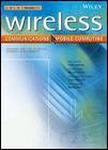版权所有:内蒙古大学图书馆 技术提供:维普资讯• 智图
内蒙古自治区呼和浩特市赛罕区大学西街235号 邮编: 010021

作者机构:School of Software Engineering Beijing Jiaotong University Beijing100091 China School of Computer and Information Technology Beijing Jiaotong University Beijing100091 China Rizhao Big Data Development Bureau Rizhao276826 China The Commonwealth Scientific and Industrial Research Organisation Sydney Australia
出 版 物:《Wireless Communications and Mobile Computing》 (Wireless Commun. Mobile Comput.)
年 卷 期:2023年第2023卷第1期
核心收录:
学科分类:0810[工学-信息与通信工程] 0809[工学-电子科学与技术(可授工学、理学学位)] 081203[工学-计算机应用技术] 08[工学] 0835[工学-软件工程] 0812[工学-计算机科学与技术(可授工学、理学学位)] 0823[工学-交通运输工程] 082301[工学-道路与铁道工程]
摘 要:A vehicular network is expected to empower all aspects of the intelligent transportation system (ITS) and aim at improving road safety and traffic efficiency. In view of the fact that spectrum scarcity becomes more severe owing to the increasing number of connected vehicles, implying spectrum sensing technology in vehicular network, i.e., cognitive vehicular network, has emerged as a promising solution to provide opportunistic usage of licensed spectrum. However, some unique features of vehicular networks, such as high movement and dynamic topology, take on high challenges for spectrum sensing. Recently, machine learning-based approaches, especially deep learning, for spectrum sensing have attracted sufficient interest. In this work, we investigate a learning-based cooperative spectrum sensing (CSS) approach for multiband spectrum sensing in the cognitive vehicular network. Specifically, we integrate two powerful deep learning models, i.e., the convolutional neural network (CNN) to exploit the features from sensing data, and the long-short-term memory (LSTM) network is then utilized to extract temporal correlations given input as the generated features by the CNN structure. Instead of the predefined decision threshold typically set in conventional approaches, our proposed approach could eliminate the impact of impertinent threshold value setting. Extensive simulations have been conducted to evaluate the effectiveness of the proposed method in achieving satisfactory spectrum sensing performance, particularly in terms of higher detection accuracy, robustness in low signal-to-noise ratio (SNR) environments, and a significant reduction in spectrum sensing time compared to other methods. © 2023 Lingyun Lu et al.